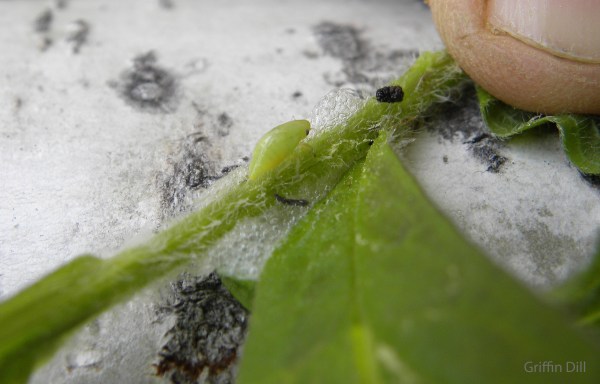Have you ever wondered about the “spittle” that adorns plants in the summertime? This frothy white substance, wrapped around wildflower stems and dripping off leaves, is often called “snake spit,” but it has nothing to do with snakes. It’s actually the work of insects.
Spittlebugs, to be more specific.
Aptly named, spittlebugs are a group of insects in the Cercopidae family. As nymphs (immature spittlebugs), they produce foam to hide in as they feed on plant juices. This wet, bubbly shelter deters predators and prevents the spittlebugs from drying out.
“You walk through any field in Maine and you’re going to run into them,” said Charlene Donahue, an entomologist who recently retired from the Maine Forest Service. “And usually any stand of pines is going to have some on it. They’re everywhere.”
Donahue estimates there are less than 30 species of spittlebugs in Maine, but she said that the group hasn’t been well-documented and catalogued yet.
“Nobody has spent a lot of time on this group,” she said. “Most of them are not economically important and so no one bothers too much with them.”
With sucking mouthparts, spittlebugs feed on the juices of a variety of plants. Most species are harmless to the plants they feed on.
“Normally we don’t look at them as a problem,” said Jim Dill, a pest management specialist with University of Maine Cooperative Extension. “But they can be.”
There are two species — the pine spittlebug and the Saratoga spittlebug — that are considered serious pests in Maine, according to the Maine Department of Agriculture, Conservation and Forestry. Both species feed on certain types of evergreen trees. Heavy infestations can cause stunted and distorted stems and branches and can kill trees in just a few years.

This could cause problems for people who are growing certain types of trees for ornamental purposes, such as Christmas tree farmers, Dill said. In addition, some spittlebugs favor strawberry plants and can sometimes stunt the growth of berries. Still, of all the pests affecting gardens, the spittlebug is low on the priority list for management.
A spittlebug’s foam can protect it from insecticide, Dill said. A common method for getting rid of them — or at least lessening their numbers — is knocking them to the ground with a stream of water. This removes their protective foam and can cause them to dry out before they have the chance to crawl back onto the plant.
“Normally we don’t see it bad enough that it warrants any action,” Dill said.
One of the most common species of spittlebugs in Maine is the meadow spittlebug, which is found on a variety of plants, including grasses and common wildflowers such as buttercups and goldenrod. Their spittle masses are usually just under an inch in diameter, according to an online fact sheet from the University of Minnesota Extension. Tucked inside, the nymph has a soft, elongated body that’s up to a quarter inch in length. It has a large red eye on either side of its head, and its body starts out yellow then morphs to green as it matures.
As the nymph feeds on plant juices, it dispels some of it from its hind end. In the process, it actually pumps air into the fluid from its abdomen, causing bubbles to form.
“It’s a secretion from the butt of the spittlebug,” Dill said, “so it’s not really spittle … A lot of people used to call it snake spit. I don’t know why. As a kid, that’s what I called it, even though I knew there was an insect in there.”
In a handful of weeks, the nymphs mature into their adult form and no longer produce foam. An adult spittlebug is sometimes called a “froghopper.” It has elongated back legs for jumping. Some species can catapult themselves more than 100 times their own body lengths, according to a 2006 study on the jumping performance of froghoppers in the Journal of Experimental Biology. While adult spittlebugs have wings, they rarely fly, though they do flap their wings from time to time and may actually use them to break their fall from such high jumps.
The colors and patterns of adult spittlebugs vary greatly by species. While the common meadow spittlebug is usually brown or gray, the dogwood spittlebug displays a pattern of bright yellow and black, and the two-lined spittlebug is marked with two distinct red-orange stripes. All three are found in Maine.
Adult spittlebugs continue to feed on plants, but they’re much more mobile than nymphs, leaping from plant to plant. In the fall, they lay egg clusters in plant debris or in leaves and stems. These remain dormant throughout the winter, then a new batch of spittlebugs emerge the following spring to adorn the landscape with “snake spit” once more.
Aislinn Sarnacki can be reached at asarnacki@bangordailynews.com. Follow her on Twitter: @1minhikegirl, and Instagram: @actoutdoors.
"feed" - Google News
July 07, 2020 at 07:19PM
https://ift.tt/31P9iXj
These bugs hide in 'snake spit' as they feed on Maine plants - Bangor Daily News
"feed" - Google News
https://ift.tt/2z3xEQN
https://ift.tt/2yko4c8
Bagikan Berita Ini














0 Response to "These bugs hide in 'snake spit' as they feed on Maine plants - Bangor Daily News"
Post a Comment